(page originally published Oct 2015, with slight edits made Dec 2021 to delete a few synesthesia types I don’t think I have anymore and to clarify a few other points.)
Synesthesia: a little bit about my experiences
I have quite a few types of synesthesia! They include:
- grapheme-color (including weekday- and month-color)
- spatial sequence (including number form)
- ordinal-linguistic personification
- smell-color, possibly
- sound-shape, possibly
- ticker tape, possibly
I first learned about synesthesia when I read the book The Name of This Book is Secret. It has a few characters with the condition and offers a general explanation. I thought it was fascinating, but didn’t think I had it. There were two pieces of information missing from my picture of synesthesia.
The first was the difference between projection and association. Projectors are synesthetes who literally experience the sensation—for example, those who actually see colors in their vision when they hear music. Associators don’t actually see the colors—they just associate a certain note with a certain color, etc. At the time, I didn’t know that associators existed, so I thought I couldn’t be a synesthete because I didn’t see colors flying around in the air, or experience other sensations in response to a stimulus.
The second thing I didn’t know was about grapheme-color synesthesia. I thought synesthesia was limited to crosses between the five regular senses—not numbers and letters too. In grapheme-color synesthesia, which is possibly my strongest type, I associate specific colors with each number and letter of the alphabet.
Here’s my alphabet:
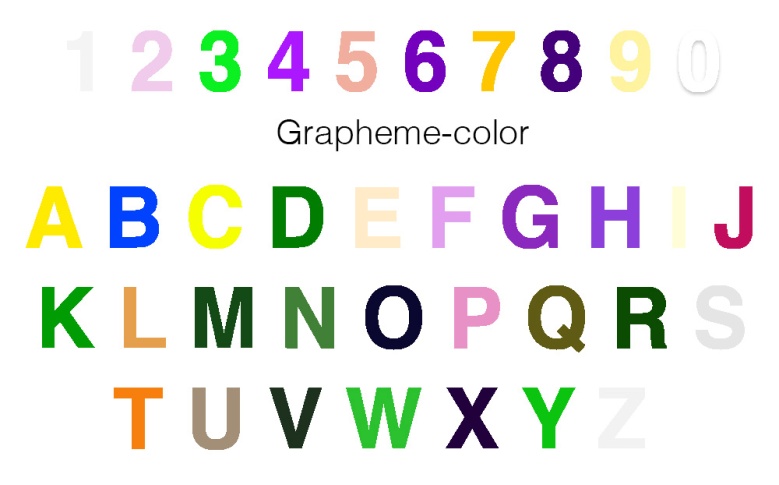
Actually, when looking through work I did when I was younger, you can see very subtle signs of my synesthesia. When coloring letters on a poster, many of the colors would inadvertently be those in my synesthetic alphabet. And when imagining a visualization of a Higgs boson (a type of subatomic particle), I colored it lavender purple—exactly the color of an H.
I finally realized I had it after reading A Mango-Shaped Space, one of those rare books all about a synesthetic protagonist. The main reason I realized was not just because of the book’s depiction of synesthesia—rather, how the character’s experiences with the condition were different than mine. Mia—the main character—would describe the colors of words and numbers, and I would think to myself, “NO! That’s the wrong color!” I spent a couple days thinking more about it, and drawing my alphabet out as well.
I’ve never been officially “diagnosed” with synesthesia—the closest I’ve come was in August, when I took the Synesthesia Battery, a series of online synesthesia tests. The results pretty much proved I had it, even though I had accepted it long before. For all you other synesthetes, I highly recommend taking the Battery—you learn about yourself and your synesthesia, in addition to contributing to scientific research!
A word about spelling with synesthesia: I’m a pretty good speller, but not perfect. I still make mistakes. However, I hardly ever make mistakes with the first letter of the word, since the color of the first letter changes the color of the word. Vowels are harder, since A, E, I, and U are similar colors.
Number form and ticker tape are different stories. I realized I had those after reading the Wikipedia page on it (number form), or reading a person’s description of it (ticker tape).
How do you visualize the progression of numbers in your head? It’s probably a straight number line, like what you see in classrooms. Number form means, very simply, that the number line in my head is crooked. It goes diagonally up from zero, then turns left at 10, then right at 20, then left again at 100… etc. I also imagine a point in actual space that represents each number, with zero being about six inches away from my nose, and getting progressively higher and further away until my arm can’t reach to point to the number.
The funny thing is, I also have a spatial form for many other types of sequences (though I can’t point to them in space like I can for numbers; these ones are all in my head). My mental timeline and alphabet are slightly crooked as well. The year is a counterclockwise oval, as are days and weeks. The five different series of Star Trek are all in certain positions relative to one another. And unlike grapheme-color, sequences have been arranged in this way for as long as I can remember.
Here are drawings of my spatial sequences for numbers, the year, the alphabet, and Star Trek:
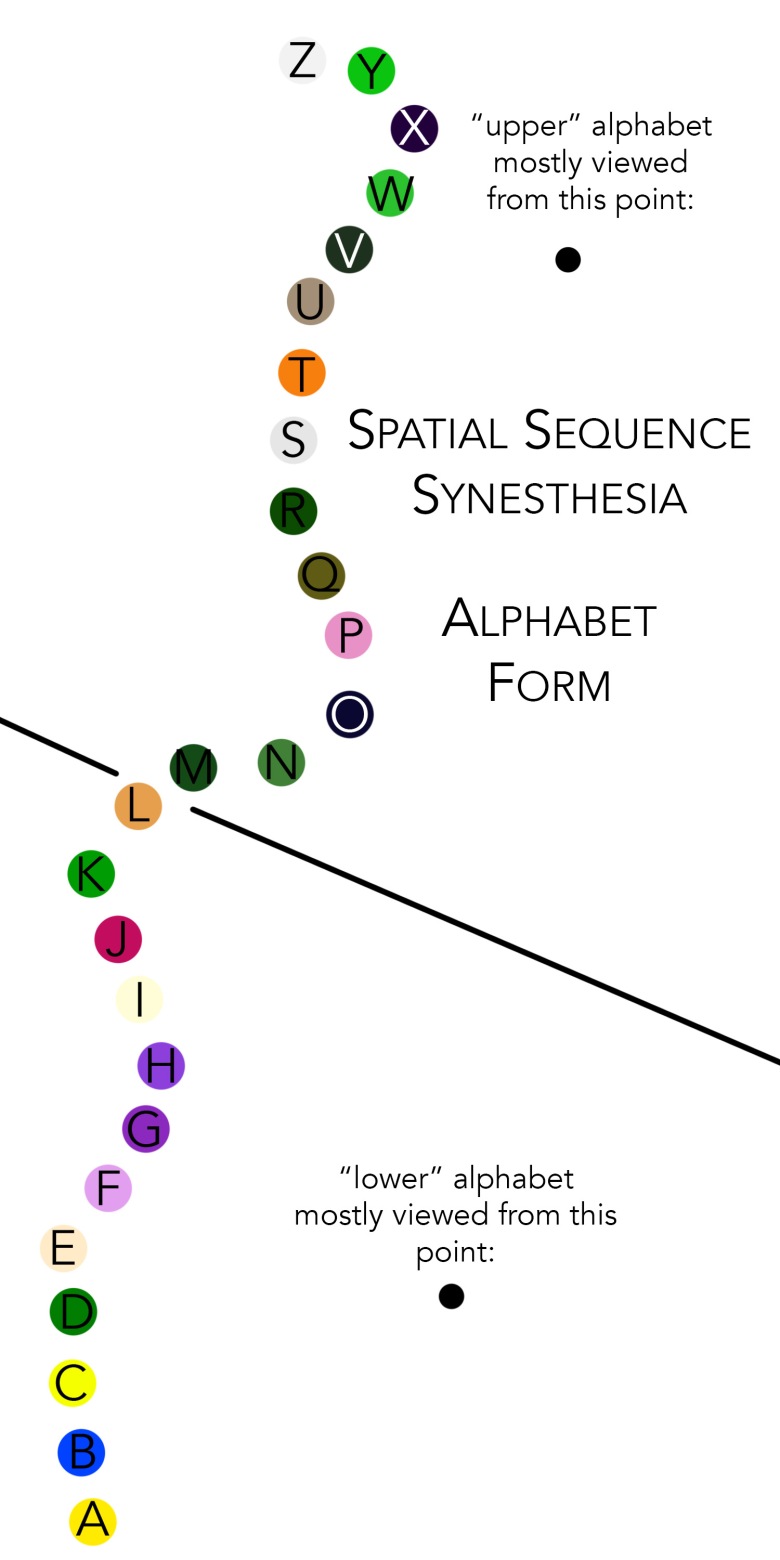
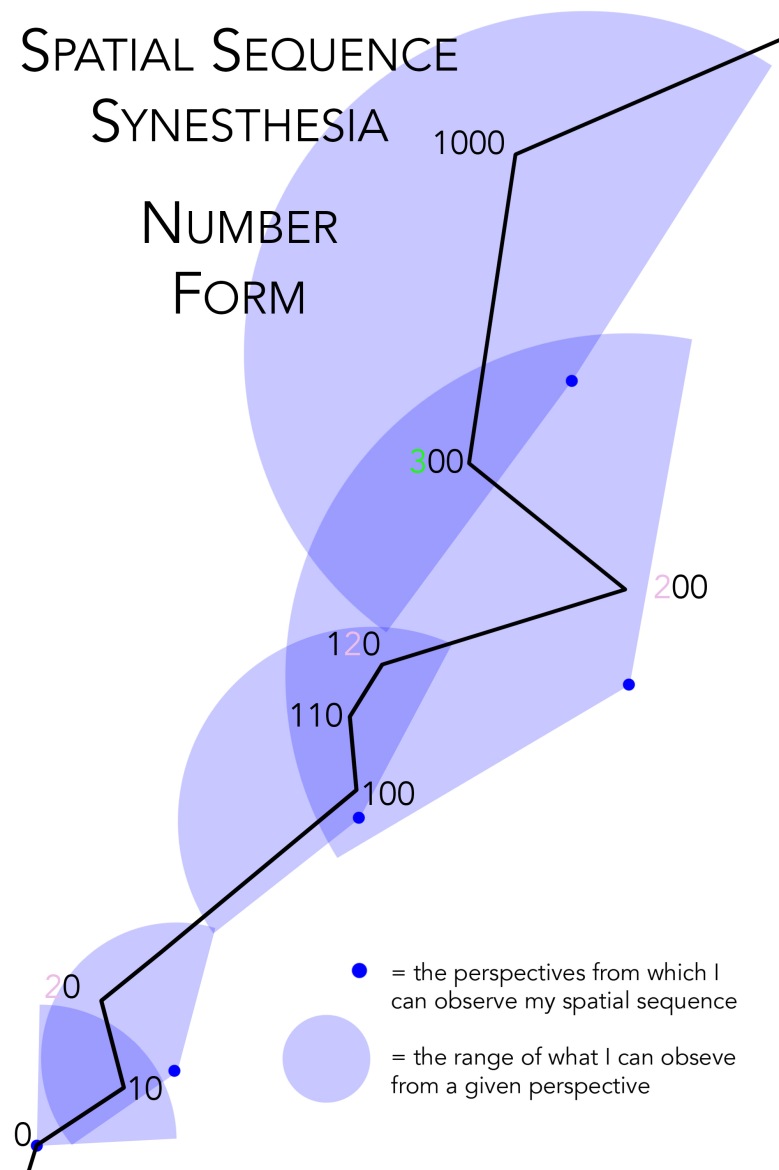
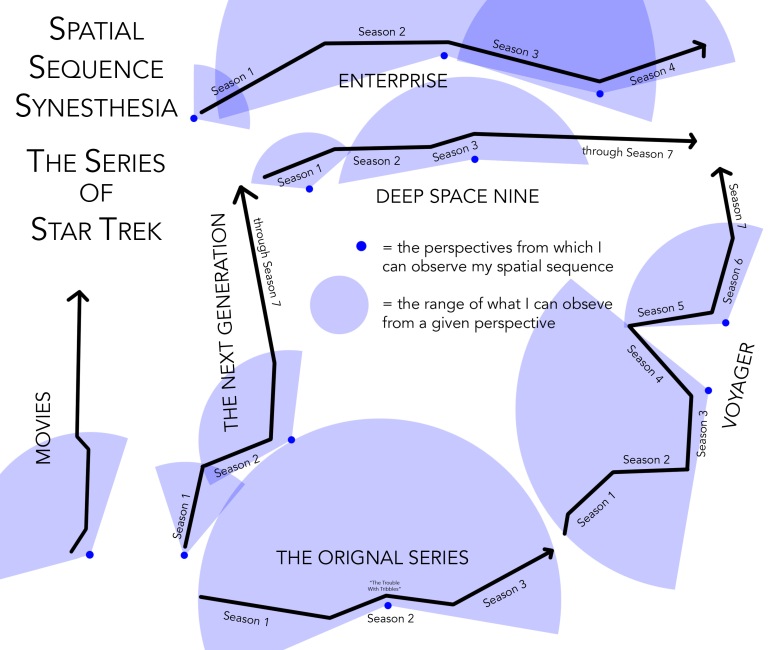
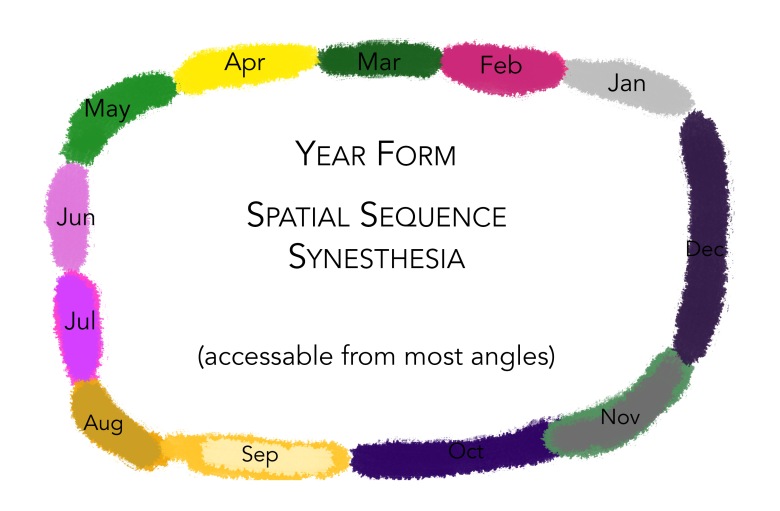
I’m still not 100% sure if I have ticker tape, but I think it’s likely. Whenever I hear someone speak, I picture the words they’re saying in my head. It is NOT like having a built-in subtitle system; in fact it’s a little like the opposite. I don’t picture the word unless I know it, which means that it won’t happen if I’m listening to something I don’t understand—speaking too fast, too slow, too quiet, a different language, etc. This makes it so that I have to know how to spell a word if I want to remember it, because if I don’t know (roughly) how to spell it, it won’t show up on my synesthetic ticker tape.
More about (projected) ticker tape synesthesia here.
Sound-shape is exactly what it sounds like: I associate certain sounds with shapes. This is NOT the same thing as chromesthesia (sound-color, music-color, or note-color). I found out I had it when I took a hearing test. You know those little beeps they make you listen to? Well, I thought, “That sounds exactly like one of those soft Photoshop brushes!” Since then, I find that I can draw the shape of some sounds and/or relate them to other Photoshop brushes.
Another interesting thing about sound-shape is that everyone, even non-synesthetes, have some form of it!
I only have smell-color for certain smells—usually only if there isn’t a visual stimulus to go along with it. For example, if I smell a lemon, the smell will be yellow, but only because the lemon is yellow. The strongest associations I have for scents is that of my hair (weird, huh?). After I wash my hair it smells purple, normally it smells light or dark yellow, and when it really needs to be washed it’s orange, or red.
Now for my favorite type: ordinal-linguistic personification. OLP is where I imagine the letters of the alphabet as having personalities! I drew all of them on Photoshop:
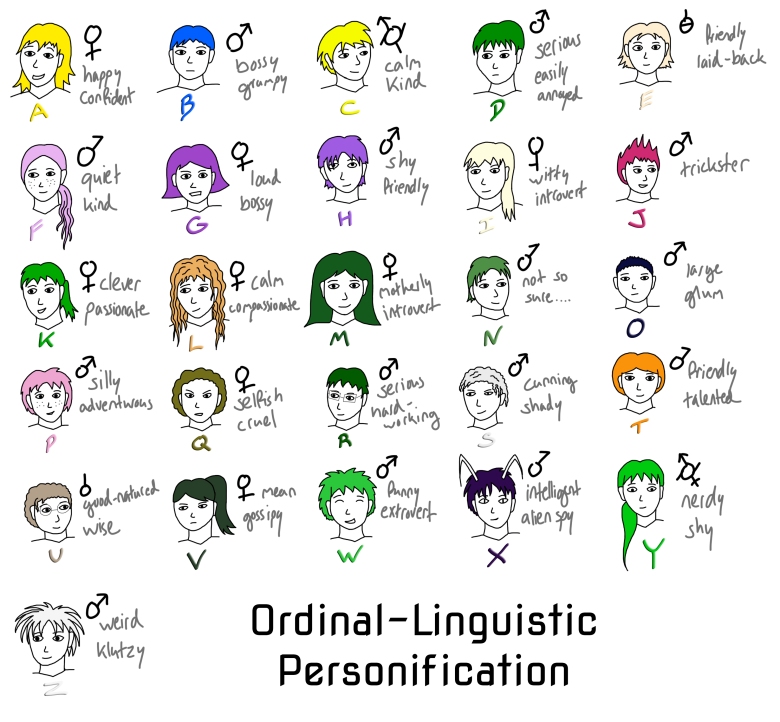
I learned about my OLP from the letter Q. She is the most evil letter in my alphabet. (And to think, Q is the symbol for a rational number!) When I was a kid, many of my make-believe villains had names starting with Q. And now I know why!
(EDIT 2021: Interesting coming back to this after having studied Chinese. I have a more positive association with the letter Q now, given how common it is in romanized representations of Chinese words, but I wouldn’t say the negative associations have gone away entirely.)
I’ve also personified or associated colors with other sequences, most notably the Periodic Table of the Elements, but I’m not sure if the associations are strong enough to be synesthetic.
And a couple more notes about synesthesia:
- I don’t actually SEE the colors, words, spatial sequences, etc. They are all in my head.
- Spatial sequence is the one type of synesthesia I absolutely cannot imagine living without. The way I picture sequences is integral to the way I think. (My number form is also integral to the way I do math in my head!)
- When given a number like 47 that has two or more digits, I don’t see the number as a whole other color—I see it as the colors of 4 and 7. So 47 would be purple and yellow.
- 4, 6, and 8 are all purple, so that’s why I tend to confuse numbers that have many even digits in them.
- Contrary to popular belief, synesthesia does not make you bad at math, good at memorization, or a musical prodigy.
- I conducted a couple surveys about synesthesia—if you’re interested, I wrote some pages describing the results!
That’s all for now—feel free to leave questions in the comments!